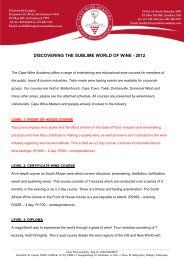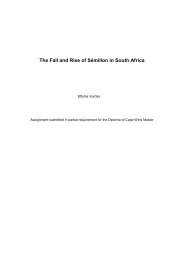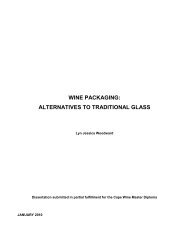micro-oxygenation in contemporary winemaking - Cape Wine ...
micro-oxygenation in contemporary winemaking - Cape Wine ...
micro-oxygenation in contemporary winemaking - Cape Wine ...
You also want an ePaper? Increase the reach of your titles
YUMPU automatically turns print PDFs into web optimized ePapers that Google loves.
Micro-<strong>oxygenation</strong> <strong>in</strong> Contemporary W<strong>in</strong>emak<strong>in</strong>gthey promote the modifications <strong>in</strong> mouthfeel and colour stability but argue that thesechanges are not about hasten<strong>in</strong>g age<strong>in</strong>g or allow<strong>in</strong>g earlier release of the w<strong>in</strong>e.Presumably, they are concerned with the negative connotations of premature age<strong>in</strong>g andimplications for long-term longevity, but the semantic dist<strong>in</strong>ctions are not completely clearor conv<strong>in</strong>c<strong>in</strong>g, and it is somewhat of a stretch to present <strong>micro</strong>-<strong>oxygenation</strong> as actually<strong>in</strong>creas<strong>in</strong>g longevity.The other stated benefits of <strong>micro</strong>-<strong>oxygenation</strong> have to do with improvements <strong>in</strong> aroma andflavour. It is frequently claimed that <strong>micro</strong>-<strong>oxygenation</strong> is effective <strong>in</strong> decreas<strong>in</strong>g vegetativeand herbaceous flavours of w<strong>in</strong>e (Parish et al., 2000; Paul, 2002; Blackburn, 2004). Theorig<strong>in</strong>s of this claim are unclear s<strong>in</strong>ce there is no obvious association betweenherbaceousness and reductive or oxidative conditions, but it may be l<strong>in</strong>ked to the notionthat <strong>micro</strong>-<strong>oxygenation</strong> is successful <strong>in</strong> mitigat<strong>in</strong>g the effects of harsh green tann<strong>in</strong>s.The contention that <strong>micro</strong>-<strong>oxygenation</strong> is able to decrease the sulphide aromas associatedwith reduction seems more logical and is somewhat easier to understand. However, thesimplistic argument that problems caused by reduction can be easily corrected by oxidationor <strong>oxygenation</strong> should not be accepted uncritically because many of the malodorousreductive sulphur compounds are extremely resistant to all corrective efforts andtreatments (Ribéreau-Gayon et al., 2006b).A number of other possible benefits of <strong>micro</strong>-<strong>oxygenation</strong> are mentioned less frequently <strong>in</strong>the <strong>in</strong>dustry. These <strong>in</strong>clude: Micro-<strong>oxygenation</strong> could <strong>in</strong>crease long-term oxidative stability, provid<strong>in</strong>g someprotection aga<strong>in</strong>st later, more harmful, oxidation (Parish et al., 2000); A related idea is that the use of <strong>micro</strong>-<strong>oxygenation</strong> could lower SO 2 requirements <strong>in</strong>w<strong>in</strong>emak<strong>in</strong>g (Rob<strong>in</strong>son, 2006; Theron, 2007); Micro-<strong>oxygenation</strong> produces more complex w<strong>in</strong>es than sta<strong>in</strong>less steel tank productionalone (Bird, 2005); Micro-<strong>oxygenation</strong> used before alcoholic fermentation could provide additional oxygenfor yeast metabolism and decrease the <strong>in</strong>cidence of sluggish or stuck fermentations(Paul, 2002; Zoeckle<strong>in</strong> et al., 2003); and Micro-<strong>oxygenation</strong> could be used to prolong white w<strong>in</strong>e maturation on lees produc<strong>in</strong>gw<strong>in</strong>es with <strong>in</strong>creased body and freshness.12
















